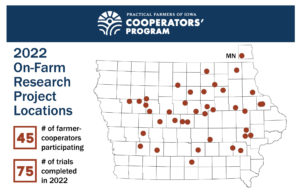2022 Cooperators’ Program Report
Since 1987, PFI’s Cooperators’ Program has empowered curious farmers to conduct on-farm experiments that answer their questions and guide their decision-making. Our program is unique in that farmers have always been at the helm – they are the ones brainstorming projects, setting on-farm research priorities and gathering the data on their farms.
While PFI staff guide farmers through the process of setting up an on-farm trial (and no prior research experience is necessary), farmers are very much partners and leaders in the process. Most on-farm research trials take place on the farms of participating farmers, and the Cooperators’ Program research agenda is developed and carried out by farmers.
What’s a “cooperator?”
We refer to our farmer-researchers as cooperators because the first experiments in the program were done in cooperation with agricultural researchers. Nowadays, on-farm research trials are collaborative efforts between farmers and PFI staff scientists who guide the design of experiments based on questions posed by the participating farmers. On-farm research projects are also often collaborative endeavors among several farmers. So “cooperator” applies on many levels!
Do I have to be a “scientist” to participate?
Not at all! You do not need a research or science-based background to participate. All you need is an idea you want to test on your farm and PFI’s staff scientists help with the rest. That said, just like scientists, you are making observations about your farm – and decisions based on available data – on a regular basis. So you’re arguably a scientist already! What we do in the Cooperators’ Program is empower you to answer your pressing farm questions using the simple yet rigorous tools of scientific research.
How exactly does it work?
Each year, farmers who have conducted on-farm research – and those who’ve told us they aspire to – are invited to our annual Cooperators’ Meeting. Held in December, this gathering is about connecting as a community of on-farm researchers, and focuses on sharing results and observations from the past year’s farmer-led research trials.
During the meeting, cooperators are encouraged to describe what they did, why they did it and what they found. Cooperators also generate ideas and make plans for future projects based on previous results and new questions. Before the onset of spring, cooperators and PFI staff mutually agree on project plans and commitments.
When the time comes to conduct the trials, farmers are ultimately responsible for planting seeds, tending to animals and taking measurements throughout a trial.
What will I gain from participating?
Useful, reliable research that helps you understand what works and what doesn’t on your farm
Connection with a community of curious farmers with whom you can exchange ideas and experiences, and who can help you expand your knowledge of what’s possible with on-farm research
The chance to become a leader who inspires improvements to our agricultural landscape
Okay, you’ve got me hooked. I have something I’d like to investigate on my farm. What should I do now?
We’d love to hear about it! Contact Stefan Gailans, senior research manager, to learn more and get started.
I can’t be a farmer-researcher but would like to see the results. How can I do that?
The results of our Cooperators’ Program research provide relevant, unbiased and science-based information that farmers can trust about new practices. You’ll see summaries of our 2021 research in the following pages. For more in-depth results (as well as reports from previous years’ trials), visit us online at practicalfarmers.org/research.
Download a PDF of the Cooperators’ Program Report.
Timing of Roll-Crimping Rye Cover Crop and Planting Soybeans
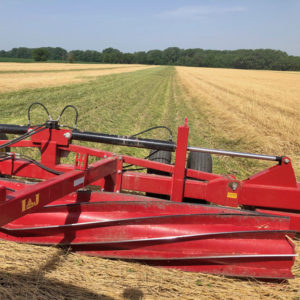 The organic no-till movement emphasizes eliminating both chemical and tillage inputs in crop production. The research on organic no-till clearly shows that successful weed control with cover crops relies on consistent, thick cover crop biomass and effective mechanical forms of cover crop termination (e.g., roller-crimpers). However, determining when to mechanically terminate a cover crop is difficult as there are tradeoffs with weed control benefits, termination efficacy and cash crop yield.
The organic no-till movement emphasizes eliminating both chemical and tillage inputs in crop production. The research on organic no-till clearly shows that successful weed control with cover crops relies on consistent, thick cover crop biomass and effective mechanical forms of cover crop termination (e.g., roller-crimpers). However, determining when to mechanically terminate a cover crop is difficult as there are tradeoffs with weed control benefits, termination efficacy and cash crop yield.
Though he is not a certified organic grower, Jon Bakehouse recently purchased a roller-crimper and wanted to know how to best use it to terminate a cereal rye cover crop in the soybean phase of his crop rotation. Jon compared soybean yield and overall profitability of roll-crimping + planting soybeans at two different stages of the cereal rye cover crop’s development: at the anthesis (flowering) stage of cereal rye, and several weeks later at the dough (grain physiological maturity) stage of cereal rye.
Can We Reduce N Rates and Improve ROI?
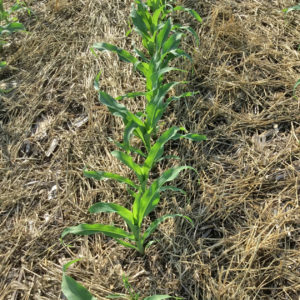 Corn farmers are wondering if the soil health-building practices they have implemented in the past five-plus years – such as reduced tillage, cover crops, diversified rotations and others – will let them reduce their typical N rates. Sixteen farmers put their soil health to the test in 17 replicated strip trials comparing their typical nitrogen rate against that rate reduced by 15%-45%. If farmers can maintain corn yields and save money at the reduced N rate, they might feel more confident reducing (or at least questioning) fertilizer rates going forward.
Corn farmers are wondering if the soil health-building practices they have implemented in the past five-plus years – such as reduced tillage, cover crops, diversified rotations and others – will let them reduce their typical N rates. Sixteen farmers put their soil health to the test in 17 replicated strip trials comparing their typical nitrogen rate against that rate reduced by 15%-45%. If farmers can maintain corn yields and save money at the reduced N rate, they might feel more confident reducing (or at least questioning) fertilizer rates going forward.
And what if the reduced N rate lowers corn yields and loses money? Farmers will still have gained valuable information: They can be more assured that their typical nitrogen rate is the best rate for their farm at this time, and better equipped to gauge how additional soil health-promoting practices could help reduce it in the future.
Flame-Weeding Organic Soybeans
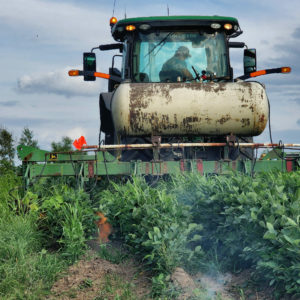 Flame-weeding is an organic weed control method in which weed plant tissues are exposed to propane-fueled flames, injuring or killing the weed. Daniel Sheetz wondered if adding flame-weeding to his standard weeding practices could decrease weed pressure in his organic soybean production. Together with PFI staff, Daniel designed an experiment with two treatments: 1) his standard practices of tine-weeding, rotary hoeing and three successive passes of cultivation compared with 2) his standard practices plus an additional pass with a flame weeder. Daniel’s original plan was to flame-weed between the first and second cultivation passes. He was unable to do that and ended up flame-weeding on July 26 after the third cultivation pass.
Flame-weeding is an organic weed control method in which weed plant tissues are exposed to propane-fueled flames, injuring or killing the weed. Daniel Sheetz wondered if adding flame-weeding to his standard weeding practices could decrease weed pressure in his organic soybean production. Together with PFI staff, Daniel designed an experiment with two treatments: 1) his standard practices of tine-weeding, rotary hoeing and three successive passes of cultivation compared with 2) his standard practices plus an additional pass with a flame weeder. Daniel’s original plan was to flame-weed between the first and second cultivation passes. He was unable to do that and ended up flame-weeding on July 26 after the third cultivation pass.
Clover Cover Crop Termination Date for a Rye-Corn System
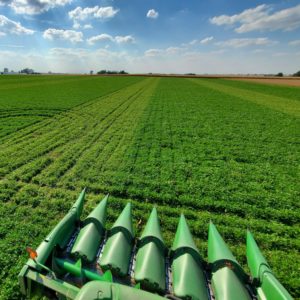 Since expanding his corn-soybean crop rotation to include small grains over the past decade, Dick Sloan has conducted several experiments aimed at optimizing management of a nitrogen-fixing green manure cover crop between the small grain and corn phases of his rotation. This year, Dick was curious about how the termination date of clover green manure might affect nitrogen availability to a succeeding crop. He commented, “By maximizing nitrogen availability from the clover cover crop, I will minimize my need for nitrogen in the corn year of my rotation.”
Since expanding his corn-soybean crop rotation to include small grains over the past decade, Dick Sloan has conducted several experiments aimed at optimizing management of a nitrogen-fixing green manure cover crop between the small grain and corn phases of his rotation. This year, Dick was curious about how the termination date of clover green manure might affect nitrogen availability to a succeeding crop. He commented, “By maximizing nitrogen availability from the clover cover crop, I will minimize my need for nitrogen in the corn year of my rotation.”
Dick compared corn yields and net financial returns under three different clover cover crop termination strategies: 1) fall termination, 2) spring termination and 3) spring suppression. He hypothesized that terminating clover in the fall would provide more nitrogen in the corn year and greater corn yield than terminating or suppressing the clovers in the spring.
Cover Crops for Winter Squash
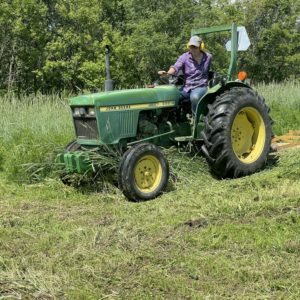 Cover crops are planted by many vegetable growers between crop cycles for the multitude of benefits they provide. Kate Edwards had previous success growing cereal rye as a cover crop and had heard of other growers having success with hairy vetch, a leguminous cover crop that has the added benefit of providing nitrogen for the next crop.
Cover crops are planted by many vegetable growers between crop cycles for the multitude of benefits they provide. Kate Edwards had previous success growing cereal rye as a cover crop and had heard of other growers having success with hairy vetch, a leguminous cover crop that has the added benefit of providing nitrogen for the next crop.
However, Kate knew vetch would not be a good cover crop option before most of her crops. “To get the best results from vetch, you have to wait to incorporate it until after it flowers,” she commented. “Winter squash and our other fall crops are the only crops planted late enough to do this.” With this background knowledge, Kate decided to test how hairy vetch and cereal rye each affected squash yields.
Living Mulch for Pathway Weed Management in Bell Peppers
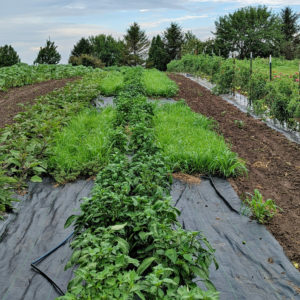 Managing weeds in the aisles between rows of plasticulture vegetables can be challenging and time-consuming. Some common weed suppression methods include applying mulches such as straw and corn stover, adding landscape fabric or planting a living mulch, which is a cover crop grown simultaneously to a cash crop. Living mulches have gained attention for potential soil health and other benefits in recent years. However, they can compete with the cash crops for water and nutrients.
Managing weeds in the aisles between rows of plasticulture vegetables can be challenging and time-consuming. Some common weed suppression methods include applying mulches such as straw and corn stover, adding landscape fabric or planting a living mulch, which is a cover crop grown simultaneously to a cash crop. Living mulches have gained attention for potential soil health and other benefits in recent years. However, they can compete with the cash crops for water and nutrients.
Kate Edwards and Mark Quee were curious about how planting a living mulch would affect crop yield compared to other weed-suppression methods. Both farmers decided to test the effect of living versus non-living mulch on pepper yields. Kate used straw as a non-living mulch while Mark tried landscape fabric.
Pruning vs. Caging Heirloom Tomatoes in High Tunnel
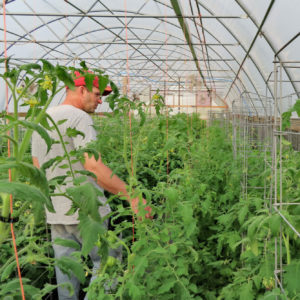 Single-leader pruning is a standard management practice for growing high tunnel tomatoes. However, Lee Matteson wondered if caging his high tunnel tomatoes would improve the quantity of fruit and reduce labor costs compared to this typical practice. Lee investigated the yield of ‘Beauty King,’ an indeterminate heirloom tomato, under two management treatments: 1) single-leader pruning and 2) caging with no pruning.
Single-leader pruning is a standard management practice for growing high tunnel tomatoes. However, Lee Matteson wondered if caging his high tunnel tomatoes would improve the quantity of fruit and reduce labor costs compared to this typical practice. Lee investigated the yield of ‘Beauty King,’ an indeterminate heirloom tomato, under two management treatments: 1) single-leader pruning and 2) caging with no pruning.
Fine-Tuning Fertility for Better Broccoli
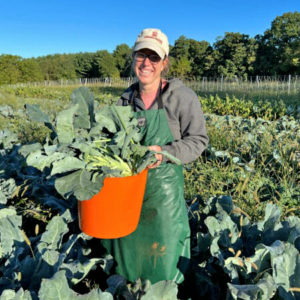 In this trial, Hannah Breckbill, Emily Fagan, Kate Edwards and Mark Quee wanted to know how fertilizer practices on their farms affected broccoli production. “As veggie farmers,” Kate remarked, “we are often left to figure out agronomic practices from bits and pieces from other farmers at conferences and social media. There isn’t always a tried-and-true fertilizer program.” Because of this knowledge gap, experimentation is necessary for these farmers.
In this trial, Hannah Breckbill, Emily Fagan, Kate Edwards and Mark Quee wanted to know how fertilizer practices on their farms affected broccoli production. “As veggie farmers,” Kate remarked, “we are often left to figure out agronomic practices from bits and pieces from other farmers at conferences and social media. There isn’t always a tried-and-true fertilizer program.” Because of this knowledge gap, experimentation is necessary for these farmers.
Each grower had different existing fertilization practices and soil fertility, and each decided to compare their typical practice with different new practices that interested them. Hannah and Emily compared their standard dose of Sustane at planting with a larger application at planting and two split applications. Kate tested how using no fertilization compared with side-dressing with blood meal and feather meal. Mark compared no fertilization with side-dressing with blood meal.
Effect of Seeding Date on Harvest Window and Yield of Overwintered Spinach
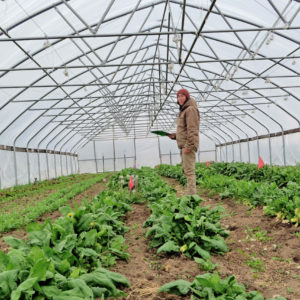 Overwintering fall-planted spinach using high tunnels and row covers gives Iowa farmers a delicious, early-spring greens crop. This spinach is highly desirable both for its sweet taste and because it can be harvested early in the season when few other crops are available. Iowa producers Emily Fagan and Hannah Breckbill of Humble Hands Harvest and Jon Yagla of The Millet Seed Farm wished to sharpen their understanding of the optimum time to plant spinach for overwintering.
Overwintering fall-planted spinach using high tunnels and row covers gives Iowa farmers a delicious, early-spring greens crop. This spinach is highly desirable both for its sweet taste and because it can be harvested early in the season when few other crops are available. Iowa producers Emily Fagan and Hannah Breckbill of Humble Hands Harvest and Jon Yagla of The Millet Seed Farm wished to sharpen their understanding of the optimum time to plant spinach for overwintering.
“It will be great to practice getting good spinach harvests as early in the year as possible, and continuing for as long as possible,” Emily said. Both farms compared yield and harvest windows of overwintered spinach planted on three fall dates.
Deworming Pasture-Raised Pigs With SwineX
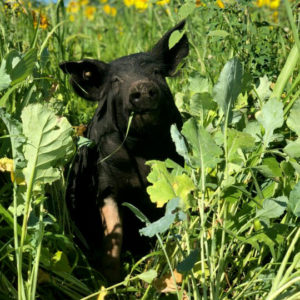 Dayna Burtness raises pigs on pasture in southeast Minnesota and has a goal of reducing her farm’s reliance on chemical dewormers. Pastured pigs are naturally exposed to parasites in soil that do not affect the humans eating the pork but can cause health problems in the pigs and poor feed-to-weight conversion ratios. To combat this, many farmers, including Dayna, use chemical dewormers (e.g. LevaMed) to reduce the parasite populations in their pigs. However, there is a concern that chemical dewormers deposited on pasture via manure may harm soil organisms and soil health. Alternative, non-chemical dewormers (e.g. SwineX) are also available and may be better for soil health.
Dayna Burtness raises pigs on pasture in southeast Minnesota and has a goal of reducing her farm’s reliance on chemical dewormers. Pastured pigs are naturally exposed to parasites in soil that do not affect the humans eating the pork but can cause health problems in the pigs and poor feed-to-weight conversion ratios. To combat this, many farmers, including Dayna, use chemical dewormers (e.g. LevaMed) to reduce the parasite populations in their pigs. However, there is a concern that chemical dewormers deposited on pasture via manure may harm soil organisms and soil health. Alternative, non-chemical dewormers (e.g. SwineX) are also available and may be better for soil health.
Dayna designed an experiment to test how treating pigs twice a year with LevaMed (in June and August) versus treating them once with LevaMed (in June) and once with SwineX (in August) affects pigs’ average daily gains and final pig weight. She hypothesized that deworming with LevaMed twice would lead to greater average daily gains.
Replacing Corn With Oats in Ration for Pasture-Raised Broiler Chickens
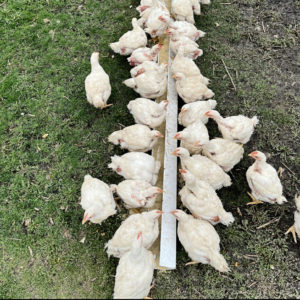 Anna Hankins and Shae Pesek, and Carlos Williams and Maja Black, raise broiler chickens on pasture and typically offer the chickens a corn and soy feed ration. They wondered whether replacing a portion of the corn in a typical ration with oats would affect weight gain and economics of the broiler chickens. Customer desire for birds fed a more diversified ration (rather than solely corn and soybeans) was the inspiration for this project. However, the ration with oats would have to be similarly priced and perform similarly to the typical feed to make economic sense. “Chicken has a very small profit margin, which is why feed efficiency is so important,” Carlos said at the onset.
Anna Hankins and Shae Pesek, and Carlos Williams and Maja Black, raise broiler chickens on pasture and typically offer the chickens a corn and soy feed ration. They wondered whether replacing a portion of the corn in a typical ration with oats would affect weight gain and economics of the broiler chickens. Customer desire for birds fed a more diversified ration (rather than solely corn and soybeans) was the inspiration for this project. However, the ration with oats would have to be similarly priced and perform similarly to the typical feed to make economic sense. “Chicken has a very small profit margin, which is why feed efficiency is so important,” Carlos said at the onset.

